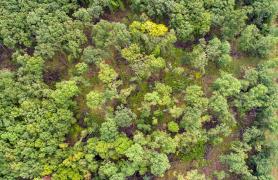In autumn, Roland Lohmar gazes out his hunting cabin window at a wetland that is human-built, but one resembling what a flood-prone creek might have carved in the Grand River bottoms long ago. With help from MDC and the U.S. Department of Agriculture’s Natural Resource Conservation Service (NRCS) wetland experts and money from programs devoted to wetlands, Lohmar hunts and watches wildlife where water depths and bank slopes are varied to boost plant diversity. Ducks and geese can cup their wings and glide in for a landing at an ideal resting and feeding place that is rich with natural foods. Shorebirds start migrating through in early fall, the retired doctor from Columbia said. Lohmar has hunted in the bottoms of Chariton County since his boyhood in 1941.
“We get them in numbers like we’ve never seen before,” he said.
Waterfowl hunting is often a goal when landowners build or renovate wetlands. But nongame wildlife also benefits. In 1997, Mike McClure, MDC wetland services biologist, helped a landowner in Sullivan County develop marshes with financial help from the NRCS-administered Wetland Reserve Easement Program. This summer, that wetland hosted the second confirmed successful trumpeter swan nest in Missouri since the late 1800s. The young swans, called cygnets, are the first since 2005, when a pair of swans produced young at a farm pond in another northern county. This summer’s cygnets are a rarity.
“To have these swans show up in Missouri, and especially in one of our projects, it’s fantastic,” McClure said. “It tells me we’re providing some good stuff out there.”
Joan FitzGerald wanted to follow the dream she and her late husband had of managing their farm for waterfowl. Plus, flooding near the Mississippi River repeatedly damaged crops on her farm in the Portage des Sioux lowlands of northeast St. Charles County. So FitzGerald and farm manager Steve Schade made a change. With the help of expertise and cost-share funds from MDC and other agencies, FitzGerald and Schade converted low areas and fields to quality wetlands or grassland meadows. A 70-acre project recently completed has varied habitat they use for hunting and wildlife watching.
“We’re not just focused on waterfowl and duck hunting,” said Shawn Duckworth, an MDC wetland services biologist who helped FitzGerald. “We’re focused on all wetland species for all seasons. Good wetland management can manage for all species and still have quality habitat come duck-hunting time.”
Partnership Power
Throughout Missouri, MDC private land wetland biologists work in partnership with the federal NRCS, the U.S. Fish and Wildlife Service (USFWS), and the nonprofit Ducks Unlimited (DU) to create, restore, or enhance wetlands on private land. They offer expertise in design and help landowners use programs that provide grants or cost-share funds. Marginal farmland, often flood-prone, becomes wetlands that help wildlife, improves water quality, reduces flooding, and enhances property values. All Missourians benefit.
The partnerships, McClure said, “have been a tremendous boost for wetland resources in the state.”
Those partnerships and funding they provide empower innovative approaches to wetland designs and renovations. The result is marshes with more benefits for wildlife, and water-control structures that are less prone to flood damage.
A typical approach in earlier decades was to put high levees around low spots in river bottoms to create standing lakes or pools flooded in autumn. Often, the water was too deep to benefit some waterfowl species. Also, levees to maintain those wetlands were often damaged by flooding from nearby rivers.
Lohmar’s 80 acres near Yellow Creek and the Grand River had some old-style pools for waterfowl hunting. Adjacent to his property is the decades-old Bosworth Hunt Club, which also had an old wetland pool. McClure and Mick Hawkins, a soil conservation technician with NRCS, helped design and implement changes at both properties. Levees were lowered to become more like broad ridges, lowering overall water levels to a foot or less in many areas. Dabbling ducks such as mallards, pintails, and teal prefer shallow waters for feeding. Plants that grow in moist areas serve as food but also host invertebrates such as insects or snails that ducks and geese eat.
Yet areas with deeper water were also created where dirt was excavated to grade out the broad ridges that replaced narrow levees. Those soil borrow pits were designed to mimic oxbows or sloughs that a meandering stream might leave after channel changes. Different plants grow in the deeper water, and those pools provide habitat for diving ducks such as scaup, canvasbacks, and mergansers. Trumpeter swans also prefer the deeper water.
Flooding is normal in the low-lying river bottoms where wetlands occur. The broad ridges being incorporated into today’s wetland construction or renovations are lower, with less pitch to their slope than historic narrow levee designs, and let flood water flow over more easily. The raised soil levels hold water where desired but suffer far less damage from severe floods, thus avoiding expensive repairs. They also create a more natural-looking wetland.
“Everything has been made to blend seamlessly with the flood plain,” McClure said. “Floods can come over the top.” The flowing water “doesn’t have the energy or the destructiveness” as when topping narrow, steep levees.
The higher ground gets attention, too, when a property is accepted as a wetland project eligible for financial assistance. A wet prairie, upland grassland, or hardwood forest may be established on drier acres, depending on the soil type.
As projects are designed, McClure said, “there’s a lot of thought about what a landowner is going to do from a hunting or viewing standpoint.”
Funding Wetland Restoration
FitzGerald’s farm in the Mississippi River bottoms had crop fields and a low place with timber when her family acquired the land in the 1960s. But the 1993 flood scoured a deep hole, which held water in the low spot. Flooding in years since posed problems for adjacent crop fields. So, when she chose to develop a wetland on those acres, Duckworth helped design a project with a berm and a water-control gate to manage water levels.
The project was completed in 2017 and gives FitzGerald and Schade a wetland complex with varied wildlife habitat. She has a duck-hunting blind on the large pool at the scour hole as well as a new berm for a future blind at a smaller open area higher in the drainage. In between are bottomland timber and a shrubby area that can be flooded in wet seasons, providing sheltered places for ducks. Plus, some old crop fields that often flooded are now planted in native prairie cordgrass, upland prairie grasses, and wildflowers. The cordgrass has already survived some recent flooding. Wildlife has a variety of places to rest, nest, and feed.
“We’re out here a lot just to watch wildlife,” FitzGerald said.
Financial aid for wetland construction or renovation varies with the type of project and the programs being used. Projects may be partially or fully funded. Federal funds are available for wetland easements and improvements via the NRCS Agriculture Conservation Easement Program — Wetland Reserve Easements (ACEP–WRE), the Continuous Conservation Reserve Program, and the USFWS Partners for Fish and Wildlife Program. A partnership between federal, state, and private conservation entities cooperate to provide funds through the Missouri Agriculture Wetland Initiative. MDC also provides cost-share funds through the Landowner Assistance Program. Money in those funds is limited, and not all projects that apply get funded in their year of application. But many do get approved and funded in time.
FitzGerald’s wetland complex is enrolled in the ACEP-WRE program. She received reimbursement for the easement value, cost-share for hydrology restoration, and cost-share for native grassland habitat restoration bordering the marsh. Prairie grasses are growing in old fields, and last autumn, FitzGerald and Schade watched hundreds of migrating wood ducks in the timbered area of the marsh. “If it wasn’t for his (Duckworth’s) expertise,” Schade said, “this probably wouldn’t have come together.”
Ongoing Expertise
MDC biologists and NRCS personnel guide contractors hired to build berms or install water-control structures. They flag where dirt is to be moved and visit farms to check berm elevations and if work matches GPS points on the plans.
But wetland biologists also assist private wetland owners for years after projects are completed. They visit projects annually or semiannually. These visits give biologists a chance to meet with landowners on their property to provide recommendations on managing for optimal wildlife habitat. They also assist with any issues that have arisen, such as clogged water-control structures or invasive plant species.
McClure confirmed that trumpeter swans had nested successfully this summer in north Missouri when he visited the farm to evaluate the condition of the wetlands.
“Once a wetland is restored, it’s managed by who owns it,” McClure said. “But we are there to give technical assistance in the management to help keep a wetland healthy and productive.”
Wetlands Benefit Owners and Wildlife
Wetlands enrolled in a conservation program provide benefits to wildlife far beyond the hunting seasons. Tommy Marshall, an MDC wetland services biologist in southeast Missouri, helps landowners with wetlands in conservation programs ranging from 40 acres to almost 2,000 acres. Those wetlands and others throughout the state are crucially important to waterfowl and shorebirds during spring migrations, when they are northward bound to their breeding grounds.
Wetlands are often established on the lowest ground that is naturally wet during spring rains. Designs for projects also help ensure water can be held on the site. Property owners are given water management plans that encourage them to hold water for migrations and lower water in summer to encourage moist soil plant growth. In spring, feeding ducks and shorebirds will gain protein from seeds such as wild millet or smartweed to give them muscle strength and fat reserves for flights north. Feeding on snails and insects also provides essential proteins and boosts calcium for egg production during nesting.
“We retain water in these wetlands, and that’s important for the spring migration,” Marshall said. “With the diversity of native plants in them, we get a high invertebrate base.”
A healthy wetland can add financial value to property. Waterfowl hunters seek out properties to buy or lease with marshes. But watching wildlife, from bald eagles to songbirds, also pulls people to wetlands.
Clint Pilcher and farm partners noticed the trumpeter swan pair staying in all seasons at their wetland, the marsh complex McClure helped design 21 years ago. They value hunting. But they were also thrilled this summer to see cygnets with the pair — proof of a successful nest for a majestic species that is endangered nationally and in Missouri.
“For us, it’s a sign that the wetland continues to have diversity and fulfills the needs of waterfowl,” Pilcher said.
“We’ve seen thousands of ducks and geese and pelicans come through. During winter, we’ve seen as many as 100 trumpeter swans on the place. It’s been pretty impressive. For us, the swans represent that the habitat is a place they feel safe and secure. We like that.”
Constructing a Wetland
MDC and NRCS wetland experts can help private landowners develop wetland construction or renovation plans, such as how berms and water control structures are placed in relation to local stream hydrology and flood history. They will also flag plan layouts and work on-site with contractors to make sure plans are being followed correctly. Staff can also do follow-up visits in subsequent years to assist landowners with issues such as invasive species or clogged water control systems.
























Also In This Issue


And More...
This Issue's Staff
Associate Editor - Bonnie Chasteen
Staff Writer - Larry Archer
Staff Writer - Heather Feeler
Staff Writer - Kristie Hilgedick
Staff Writer - Joe Jerek
Creative Director - Stephanie Thurber
Art Director - Cliff White
Designer - Les Fortenberry
Designer - Marci Porter
Photographer - Noppadol Paothong
Photographer - David Stonner
Circulation - Laura Scheuler






















